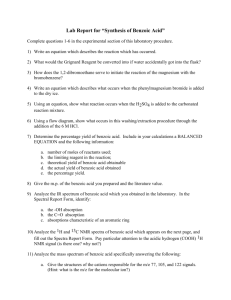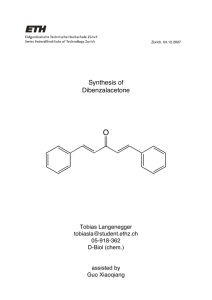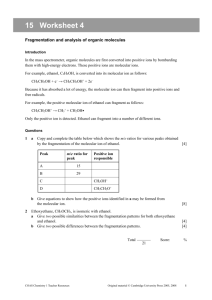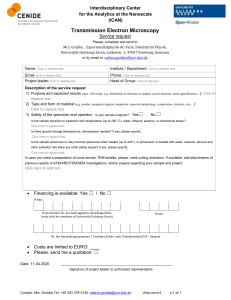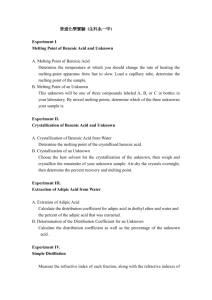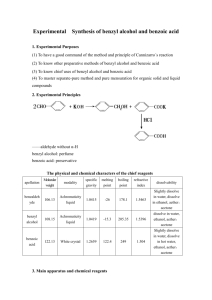Solubility
advertisement
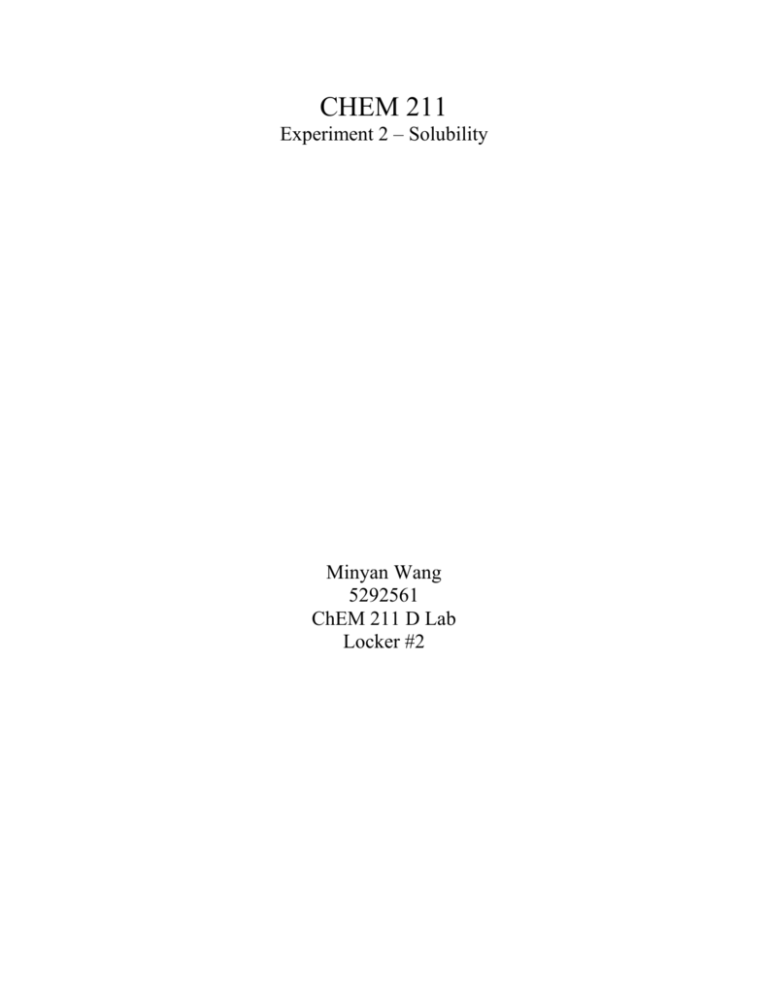
CHEM 211 Experiment 2 – Solubility Minyan Wang 5292561 ChEM 211 D Lab Locker #2 Experimental Materials used - test tubes - stir bar - steam bath - test tube clamp (used with steam bath) - 50mL beaker - gloves - 2mL pipettes - Benzoic acid - Distilled water - Ethanol - Acetone - Hexanes - Potassium permanganate - 18-crown-6 - Triethylene glycol Experimental procedure In the first part of this lab 20mg of benzoic acid was added to four test tubes. Four solvents – distilled water, ethanol, acetone, and hexanes were added to each of the test tubes. Observations were made in a solubility chart, and then the test tubes were heated in a steam bath. Observations after the steam bath were recorded. In the second part of the experiment 2mL of KMnO4 was placed into two test tubes along with 2mL toluene in each. Tetrabutylammonium was then added to one of the test tubes and observations were made. The organic layer of the tetrabutylammonium containing test tube was isolated and added to cyclohexene. In the last part of the experiment KMnO4 was added into 3 test tubes containing 2 mL of dry toluene. 5-6mg of 18-crown-6 was added into the first tube, triethylene glycol into the second, and nothing into the third. Observations were made before a drop of cyclohexene was added into the first test tube. The experiment was carried out according to the steps outlined in the lab manual, and no changes were made. Results Solute\Solvent Benzoic Acid Distilled water Insoluble Ethanol Insoluble Acetone Soluble Hexanes Insoluble Benzoic Acid and elevated temperatures Insoluble Soluble Soluble insoluble KMnO4 + Toluene Tetrabutyl ammonium bromide The organic layer is clear and is at the bottom. The top layer is purple and the organic layer is translucent with a purple tint. Soluble. Nothing No changes occurred after the shake. Insoluble. Organic layer Solute\Ligand KMnO4 Cyclohexene The color turned from having a purple tint to having a slightly yellow tint 18-Crown-6 Cloudy solution. After the addition of cyclohexene it becomes a yellow translucent solution with no solid. Soluble Triethylene Glycol A red solution is formed. soluble None No apparent reaction. Insoluble. Discussions Part 1 Acetone is a ketone, meaning it has a carbon chain with oxygen attached to it. Ethanol is an alcohol; it is an ethyl group with a hydroxyl group attached to it. Water is a very polar molecule, and hexane has no dipole moments. The solute benzoic acid dissolved in ethanol and in acetone. Both ethanol and acetone contain none polar carbon chains with polar branches. This allows the carboxyl region of benzoic acid to interact with the polar regions of these two molecules while the benzyl group interacts with the non-polar carbon chains. Ethanol would be the best for recrystallizing benzoic acid since it can be dissolved in it at slightly higher temperatures. However it is also insoluble enough in ethanol that it doesn’t dissolve at room temperature, unlike acetone. That way, benzoic acid can be dissolved and recrystallized very easily. Part 2A The tetrabutylammonium ion contains a positive nitrogen ion in the middle, which allows the negative permanganate ion to attract to it. The carbon chains that extend out from the positive ion are non-polar. This allows the ions in the middle to dissolve in non-polar solvents. With the permanganate ion attracted to the central positive ion, and the nonpolar arms, it was able to dissolve in the toluene. It was successful because there was a noticeable reaction. It was also shown to be successful because after adding cyclohexene into the non-polar organic layer there was another noticeable reaction. That could only have happened if the permanganate ion was present in the non-polar organic solvent. The second reaction is that of cyclohexene being oxidized. 3C4H8-CH=CH + 2MnO4- + 2H3O+ 3C4H8-CH(OH)-CH(OH) + 2MnO2 Part 2B The macrocyclic ligands seemed to be more effective at dissolving the ion because the solutions appeared to have one phase after shaking. While the solution still had two distinctive layers when using tetrabutylammonium bromide. The entire content of the test tube with 18-crown-6 turned into a translucent yellow solution after adding cyclohexene, meaning that the ion has dissolved. On the two macrocyclic ligands there were non-polar regions on the edge and polar regions in the center where oxygen was present. The ion is attracted to the central polar region, and the outer non-polar region allows it to dissolve in the non-polar solvents. This is different from the ammonium salt because the permanganate ion switches places with Br- and attracts to the central positive ion due to the opposite ionic charges. Findings vs Theory The findings were consistent with the theory. Benzoic acid dissolved in ethanol at slightly elevated temperatures, and once it’s been cooled crystals were reformed. In part two the salt KMnO4 was not soluble in the non-polar toluene. However using the phase transfer agents, MnO4- was dissolved in toluene. Experimental Errors The 0.5mL of solvent added to the four test tubes containing benzoic acid was an estimate using a 2mL pipette. The fact that the solvent was 0.5mL in all the beakers can have an affect on how well the solute dissolved. Some of the KMnO4 stuck to the test tubes not allowing a very clear observation to be seen.


